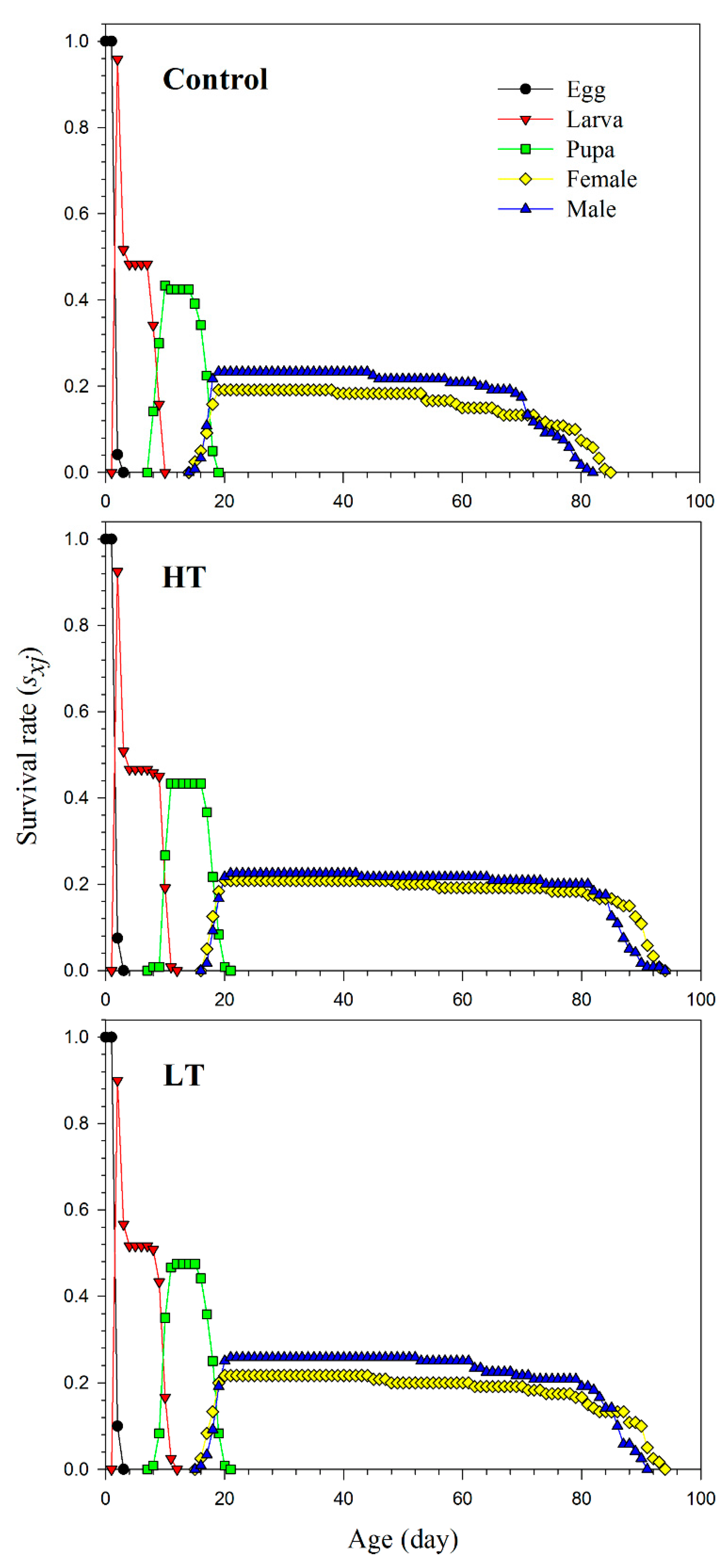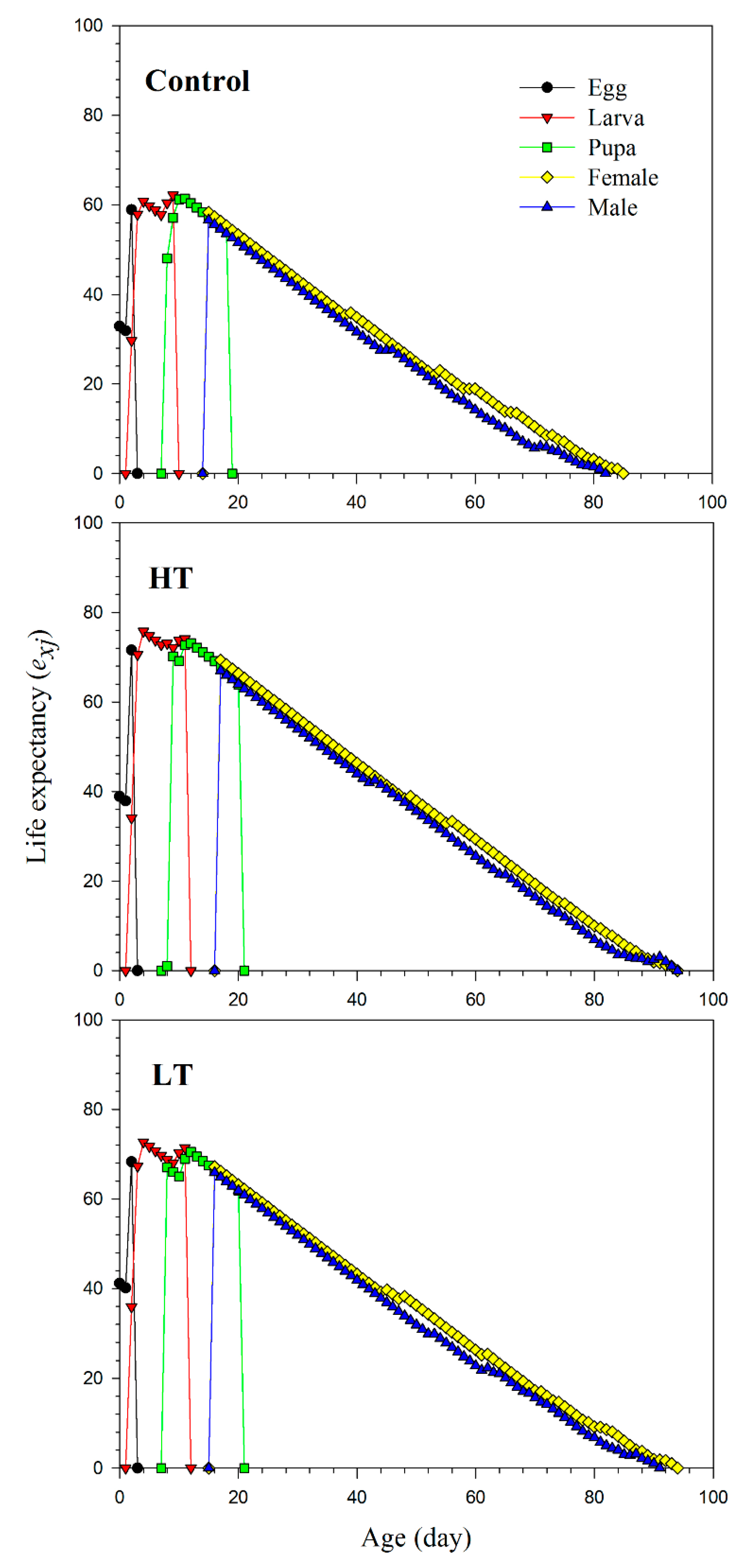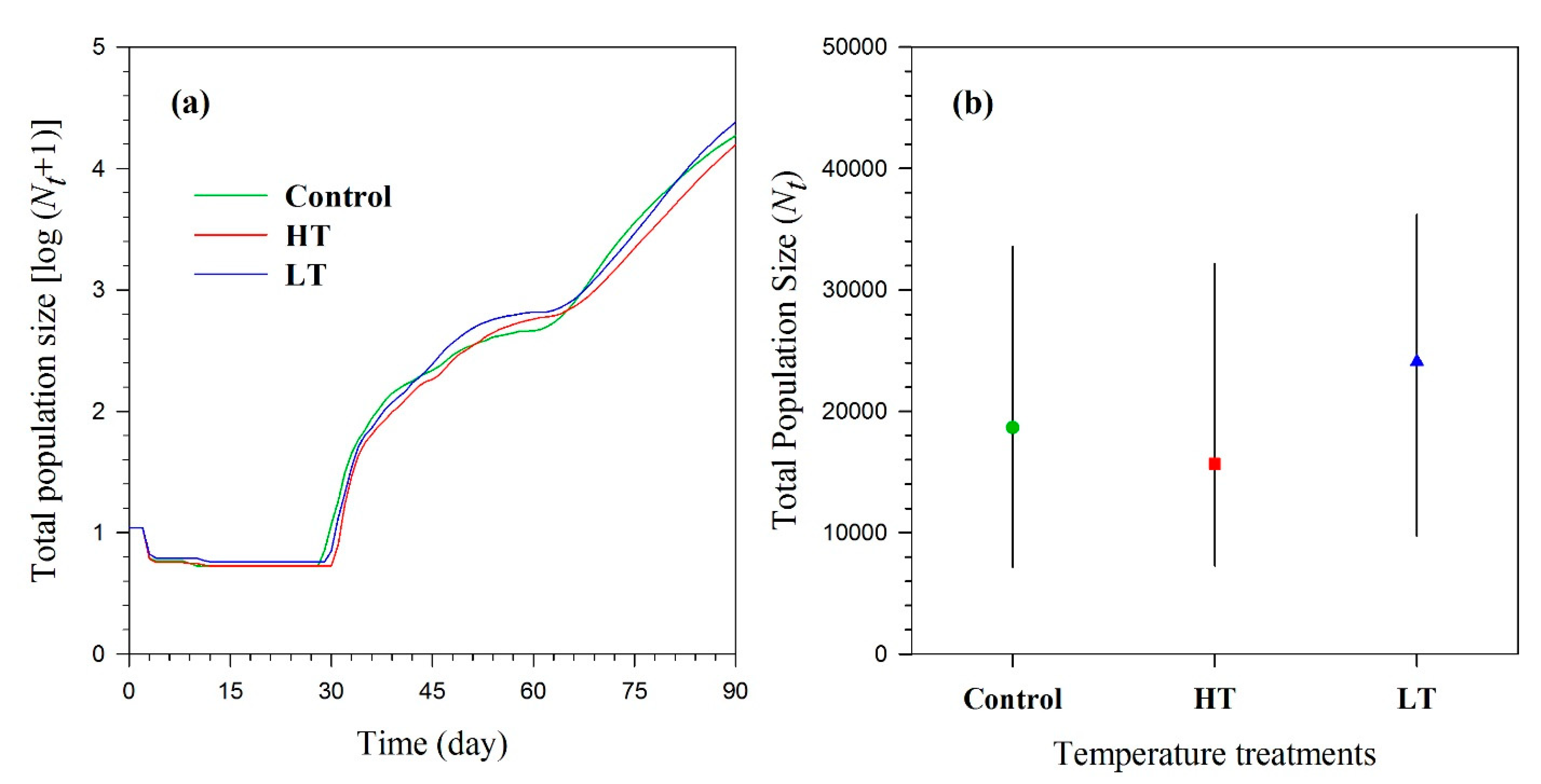Short-Term Temperature Stress Modulates Fitness Traits in Bactrocera zonata, through Negative Impact on Larval Stage
Abstract
1. Introduction
2. Material and Methods
2.1. Study Insects
2.2. Life-Table Experiments
2.3. Life-Table Data Analysis
2.4. Population Projection
3. Results
3.1. Developmental Duration and Adult Longevity of Bactrocera zonata
3.2. Fecundity and Demographic Characteristics of Bactrocera zonata
3.3. Population Projection
4. Discussion
5. Conclusions
Supplementary Materials
Author Contributions
Funding
Data Availability Statement
Acknowledgments
Conflicts of Interest
References
- Hulme, P.E. Trade, transport and trouble: Managing invasive species pathways in an era of globalization. J. Appl. Ecol. 2009, 46, 10–18. [Google Scholar] [CrossRef]
- Zhu, Y.-F.; Tan, X.-M.; Qi, F.-J.; Teng, Z.-W.; Fan, Y.-J.; Shang, M.-Q.; Lu, Z.-Z.; Wan, F.-H.; Zhou, H.-X. The host shift of Bactrocera dorsalis: Early warning of the risk of damage to the fruit industry in northern China. Entomol. Gen. 2022, 42, 691–699. [Google Scholar] [CrossRef]
- Easterling, D.R.; Meehl, G.A.; Parmesan, C.; Changnon, S.A.; Karl, T.R.; Mearns, L.O. Climate extremes: Observations, modeling, and impacts. science 2000, 289, 2068–2074. [Google Scholar] [CrossRef]
- Woods, H.A.; Dillon, M.E.; Pincebourde, S. The roles of microclimatic diversity and of behavior in mediating the responses of ectotherms to climate change. J. Therm. Biol. 2015, 54, 86–97. [Google Scholar] [CrossRef] [PubMed]
- Richard, E.; Lee, R.E., Jr.; Denlinger, D.L. Rapid cold-hardening: Ecological significance and underpinning mechanisms. In Low Temperature Biology of Insects; Cambridge University Press: Cambridge, UK, 2010; pp. 35–58. [Google Scholar]
- Elnitsky, M.A.; Hayward, S.A.; Rinehart, J.P.; Denlinger, D.L.; Lee, R.E., Jr. Cryoprotective dehydration and the resistance to inoculative freezing in the Antarctic midge, Belgica antarctica. J. Exp. Biol. 2008, 211, 524–530. [Google Scholar] [CrossRef]
- Sformo, T.; Walters, K.; Jeannet, K.; Wowk, B.; Fahy, G.; Barnes, B.; Duman, J. Deep supercooling, vitrification and limited survival to −100 °C in the Alaskan beetle Cucujus clavipes puniceus (Coleoptera: Cucujidae) larvae. J. Exp. Biol. 2010, 213, 502–509. [Google Scholar] [CrossRef]
- Zhang, W.; Chang, X.-Q.; Hoffmann, A.; Zhang, S.; Ma, C.-S. Impact of hot events at different developmental stages of a moth: The closer to adult stage, the less reproductive output. Sci. Rep. 2015, 5, 10436. [Google Scholar] [CrossRef] [PubMed]
- Nika, E.P.; Kavallieratos, N.G.; Papanikolaou, N.E. Linear and non-linear models to explain influence of temperature on life history traits of Oryzaephilus surinamensis (L.). Entomol. Gen. 2021, 41, 157–167. [Google Scholar] [CrossRef]
- Lumbierres, B.; Madeira, F.; Roca, M.; Pons, X. Effects of temperature and diet on the development and reproduction of the ladybird Oenopia conglobata. Entomol. Gen. 2021, 41, 197–208. [Google Scholar] [CrossRef]
- Wang, S.; Chen, X.; Li, Y.; Pan, B.; Wang, S.; Dai, H.; Wang, S.; Tang, B. Effects of changing temperature on the physiological and biochemical properties of Harmonia axyridis larvae. Entomol. Gen. 2020, 40, 229–241. [Google Scholar] [CrossRef]
- Ahmad, N.; Rashdi, S.S.; Niazi, S. Effect of time of the day and trap height on the catches of peach/guava fruit flies, Bactrocera zonata (Saunders) through male annihilation technique. Asian J. Plant Sci. 2003, 2, 228–232. [Google Scholar]
- Yao, F.-L.; Ding, X.-L.; Mei, W.-J.; Zheng, Y.; Desneux, N.; He, Y.-X.; Weng, Q.-Y. Impact of heat stress on the development of egg and adult coccinellid Serangium japonicum: Evidence for cross-stage and cross-generation effects. Entomol. Gen. 2020, 40, 365–376. [Google Scholar] [CrossRef]
- Alfaro-Tapia, A.; Alvarez-Baca, J.K.; Tougeron, K.; Lavandero, B.; Le Lann, C.; Van Baaren, J. Overwintering strategies and life-history traits of different populations of Aphidius platensis along a latitudinal gradient in Chile. Entomol. Gen. 2022, 42, 127–145. [Google Scholar] [CrossRef]
- Han, P.; Becker, C.; Sentis, A.; Rostás, M.; Desneux, N.; Lavoir, A.-V. Global change-driven modulation of bottom–up forces and cascading effects on biocontrol services. Curr. Opin. Insect Sci. 2019, 35, 27–33. [Google Scholar] [CrossRef]
- Danjuma, S.; Thaochan, N.; Permkam, S.; Satasook, C. Effect of temperature on the development and survival of immature stages of the carambola fruit fly, Bactrocera carambolae, and the Asian papaya fruit fly, Bactrocera papayae, reared on guava diet. J. Insect Sci. 2014, 14, 126. [Google Scholar] [CrossRef]
- Huang, Y.; Gu, X.; Peng, X.; Tao, M.; Chen, G.; Zhang, X. Effect of short-term high-temperatures on the growth, development and reproduction in the fruit fly, Bactrocera tau (Diptera: Tephritidae). Sci. Rep. 2020, 10, 6418. [Google Scholar] [CrossRef]
- Dongmo, M.A.K.; Fiaboe, K.K.; Kekeunou, S.; Nanga, S.N.; Kuate, A.F.; Tonnang, H.E.; Gnanvossou, D.; Hanna, R. Temperature-based phenology model to predict the development, survival, and reproduction of the oriental fruit fly Bactrocera dorsalis. J. Therm. Biol. 2021, 97, 102877. [Google Scholar]
- Cutler, G.C.; Amichot, M.; Benelli, G.; Guedes, R.N.C.; Qu, Y.; Rix, R.R.; Ullah, F.; Desneux, N. Hormesis and insects: Effects and interactions in agroecosystems. Sci. Total Environ. 2022, 825, 153899. [Google Scholar] [CrossRef] [PubMed]
- Le Bourg, E. Hormetic effects of repeated exposures to cold at young age on longevity, aging and resistance to heat or cold shocks in Drosophila melanogaster. Biogerontology 2007, 8, 431–444. [Google Scholar] [CrossRef] [PubMed]
- Castellanos, N.; Bueno, A.; Haddi, K.; Silveira, E.; Rodrigues, H.; Hirose, E.; Smagghe, G.; Oliveira, E. The fitness and economic benefits of rearing the parasitoid Telenomus podisi under fluctuating temperature regime. Neotrop. Entomol. 2019, 48, 934–948. [Google Scholar] [CrossRef] [PubMed]
- Zhang, G.-H.; Liu, H.; Wang, J.-J.; Wang, Z.-Y. Effects of thermal stress on lipid peroxidation and antioxidant enzyme activities of the predatory mite, Neoseiulus cucumeris (Acari: Phytoseiidae). Exp. Appl. Acarol. 2014, 64, 73–85. [Google Scholar] [CrossRef]
- Zhang, X.-S.; Wang, T.; Lin, X.-W.; Denlinger, D.L.; Xu, W.-H. Reactive oxygen species extend insect life span using components of the insulin-signaling pathway. Proc. Natl. Acad. Sci. USA 2017, 114, E7832–E7840. [Google Scholar] [CrossRef]
- Chi, H.; Liu, H. Two new methods for the study of insect population ecology. Bull. Inst. Zool. Acad. Sin. 1985, 24, 225–240. [Google Scholar]
- Chi, H. Life-table analysis incorporating both sexes and variable development rates among individuals. Environ. Entomol. 1988, 17, 26–34. [Google Scholar] [CrossRef]
- Chi, H.; You, M.; Atlıhan, R.; Smith, C.L.; Kavousi, A.; Özgökçe, M.S.; Güncan, A.; Tuan, S.-J.; Fu, J.-W.; Xu, Y.-Y.; et al. Age-Stage, two-sex life table: An introduction to theory, data analysis, and application. Entomol. Gen. 2020, 40, 102–123. [Google Scholar] [CrossRef]
- Chi, H. TWOSEX-MS Chart: A Computer Program for the Age-Stage, Two-Sex Life Table Analysis. 2022. Available online: http://140.120.197.173/ecology/Download/Twosex-MSChart-exe-B100000.rar (accessed on 2 October 2022).
- Akca, I.; Ayvaz, T.; Yazici, E.; Smith, C.L.; Chi, H. Demography and population projection of Aphis fabae (Hemiptera: Aphididae): With additional comments on life table research criteria. J. Econ. Entomol. 2015, 108, 1466–1478. [Google Scholar] [CrossRef]
- Efron, B.; Tibshirani, R. An Introduction to the Bootstrap; Chapman and 913 Hall. Inc.: New York, NY, USA, 1993; p. 914. [Google Scholar]
- Wei, M.; Chi, H.; Guo, Y.; Li, X.; Zhao, L.; Ma, R. Demography of Cacopsylla chinensis (Hemiptera: Psyllidae) reared on four cultivars of Pyrus bretschneideri (Rosales: Rosaceae) and P. communis pears with estimations of confidence intervals of specific life table statistics. J. Econ. Entomol. 2020, 113, 2343–2353. [Google Scholar] [CrossRef]
- Huang, H.-W.; Chi, H.; Smith, C.L. Linking demography and consumption of Henosepilachna vigintioctopunctata (Coleoptera: Coccinellidae) fed on Solanum photeinocarpum (Solanales: Solanaceae): With a new method to project the uncertainty of population growth and consumption. J. Econ. Entomol. 2018, 111, 1–9. [Google Scholar] [CrossRef]
- Chi, H. TIMING-MSChart: A Computer Program for the Population Projection Based on Age-Stage, Two-Sex Life Table. 2022. Available online: http://140.120.197.173/ecology/Download/Timing-MSChart-exe.rar (accessed on 2 October 2022).
- Chi, H. Timing of control based on the stage structure of pest populations: A simulation approach. J. Econ. Entomol. 1990, 83, 1143–1150. [Google Scholar] [CrossRef]
- Ma, C.-S.; Ma, G.; Pincebourde, S. Survive a warming climate: Insect responses to extreme high temperatures. Annu. Rev. Entomol. 2021, 66, 163–184. [Google Scholar] [CrossRef]
- Ullah, F.; Haq, I.; Gul, H.; Hafeez, M.; Güncan, A.; Tariq, K.; Desneux, N.; Zhao, Z.; Li, Z. Impact of temperature stress on the demographic traits and population projection of Bactrocera dorsalis Hendel. Entomol. Gen. 2022. In press. [Google Scholar] [CrossRef]
- Liu, Y.H. Effects of Temperature and Supplementary Nutrition on Population Growth of Bactrocera tau (Walker); Southwest Agricultural University: Chongqing, China, 2005. [Google Scholar]
- Khazaeli, A.A.; Tatar, M.; Pletcher, S.D.; Curtsinger, J.W. Heat-induced longevity extension in Drosophila. I. Heat treatment, mortality, and thermotolerance. J. Gerontol. Ser. A Biol. Sci. Med. Sci. 1997, 52, B48–B52. [Google Scholar] [CrossRef] [PubMed]
- Islam, Y.; Güncan, A.; Fan, Y.; Zhou, X.; Naeem, A.; Shah, F.M. Age-stage, two-sex life table and predation parameters of Harmonia axyridis Pallas (Coleoptera: Coccinellidae), reared on Acyrthosiphon pisum (Harris) (Hemiptera: Aphididae), at four different temperatures. Crop Prot. 2022, 159, 106029. [Google Scholar] [CrossRef]
- Lalouette, L.; Williams, C.; Hervant, F.; Sinclair, B.J.; Renault, D. Metabolic rate and oxidative stress in insects exposed to low temperature thermal fluctuations. Comp. Biochem. Physiol. Part A Mol. Integr. Physiol. 2011, 158, 229–234. [Google Scholar] [CrossRef] [PubMed]
- Lithgow, G.J.; White, T.M.; Melov, S.; Johnson, T.E. Thermotolerance and extended life-span conferred by single-gene mutations and induced by thermal stress. Proc. Natl. Acad. Sci. USA 1995, 92, 7540–7544. [Google Scholar] [CrossRef] [PubMed]
- Feder, M.; Blair, N.; Figueras, H. Natural thermal stress and heat-shock protein expression in Drosophila larvae and pupae. Funct. Ecol. 1997, 11, 90–100. [Google Scholar] [CrossRef]





| Parameters | Control | High Temperature (HT) | Low Temperature (LT) |
|---|---|---|---|
| Mean ± SE | Mean ± SE | Mean ± SE | |
| Eggs | 2.04 ± 0.02 a | 2.08 ± 0.02 a | 2.10 ± 0.03 a |
| Larvae | 7.02 ± 0.10 b | 8.30 ± 0.08 a | 8.10 ± 0.09 a |
| Pupae | 8.29 ± 0.09 a | 8.13 ± 0.10 a | 8.23 ± 0.12 a |
| Preadult | 17.37 ± 0.15 b | 18.56 ± 0.14 a | 18.40 ± 0.16 a |
| Adult longevity (Male) | 54.18 ± 1.74 bA | 65.15 ± 1.89 aA | 63.10 ± 1.72 aA |
| Adult longevity (Female) | 56.04 ± 2.63 bA | 68.08 ± 2.27 aA | 65.23 ± 2.52 aA |
| Total Longevity | 72.39 ± 1.50 b | 85.12 ± 1.44 a | 82.47 ± 1.52 a |
| Parameters | Control (Mean ± SE) | High Temperature (HT) (Mean ± SE) | Low Temperature (LT) (Mean ± SE) |
|---|---|---|---|
| Intrinsic rate of increase (d−1) (r) | 0.1031 ± 0.0048 a | 0.1014 ± 0.0042 a | 0.1049 ± 0.0042 a |
| Finite rate of increase (d−1) (λ) | 1.1086 ± 0.0053 a | 1.1067 ± 0.0046 a | 1.1106 ± 0.0046 a |
| Net reproductive rate (offspring/individual) (R0) | 110.85 ± 21.15 a | 146.98 ± 26.84 a | 151.32 ± 27.11 a |
| Mean generation time (days) (T) | 45.66 ± 0.56 b | 49.23 ± 0.52 a | 47.86 ± 0.49 a |
| Fecundity (eggs/female) (F) | 578.35 ± 22.25 b | 705.48 ± 28.58 a | 698.38 ± 31.38 a |
| Oviposition period (days) (Op) | 39.00 ± 6.28 a | 50.00 ± 5.21 a | 48.00 ± 5.29 a |
| Oviposition days (days) (Od) | 30.83 ± 1.67 b | 38.32 ± 1.48 a | 36.65 ± 1.63 a |
| APOP (days) | 13.13 ± 0.07 a | 13.16 ± 0.07 a | 13.19 ± 0.08 a |
| TPOP (days) | 30.43 ± 0.27 b | 31.44 ± 0.21 a | 31.15 ± 0.24 a |
Publisher’s Note: MDPI stays neutral with regard to jurisdictional claims in published maps and institutional affiliations. |
© 2022 by the authors. Licensee MDPI, Basel, Switzerland. This article is an open access article distributed under the terms and conditions of the Creative Commons Attribution (CC BY) license (https://creativecommons.org/licenses/by/4.0/).
Share and Cite
Ullah, F.; Haq, I.u.; Gul, H.; Güncan, A.; Hafeez, M.; Tariq, K.; Desneux, N.; Li, Z. Short-Term Temperature Stress Modulates Fitness Traits in Bactrocera zonata, through Negative Impact on Larval Stage. Agronomy 2022, 12, 2903. https://doi.org/10.3390/agronomy12112903
Ullah F, Haq Iu, Gul H, Güncan A, Hafeez M, Tariq K, Desneux N, Li Z. Short-Term Temperature Stress Modulates Fitness Traits in Bactrocera zonata, through Negative Impact on Larval Stage. Agronomy. 2022; 12(11):2903. https://doi.org/10.3390/agronomy12112903
Chicago/Turabian StyleUllah, Farman, Ihsan ul Haq, Hina Gul, Ali Güncan, Muhammad Hafeez, Kaleem Tariq, Nicolas Desneux, and Zhihong Li. 2022. "Short-Term Temperature Stress Modulates Fitness Traits in Bactrocera zonata, through Negative Impact on Larval Stage" Agronomy 12, no. 11: 2903. https://doi.org/10.3390/agronomy12112903
APA StyleUllah, F., Haq, I. u., Gul, H., Güncan, A., Hafeez, M., Tariq, K., Desneux, N., & Li, Z. (2022). Short-Term Temperature Stress Modulates Fitness Traits in Bactrocera zonata, through Negative Impact on Larval Stage. Agronomy, 12(11), 2903. https://doi.org/10.3390/agronomy12112903








